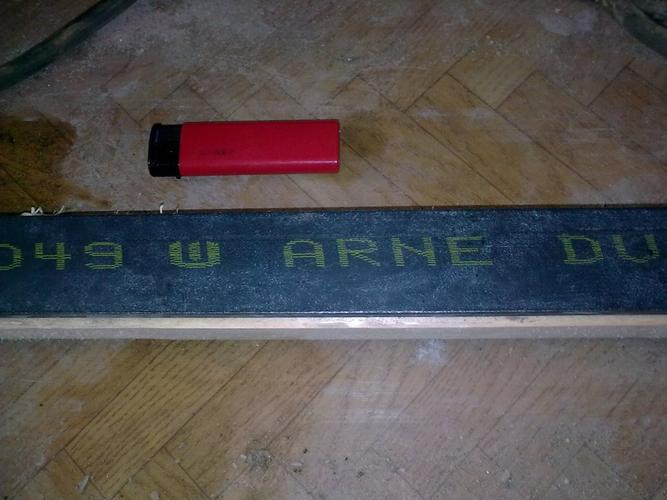Results 31 to 36 of 36
-
04-16-2013, 08:32 PM #31
 Til shade is gone, til water is gone, Into the shadow with teeth bared, screaming defiance with the last breath.
Til shade is gone, til water is gone, Into the shadow with teeth bared, screaming defiance with the last breath.
To spit in Sightblinder’s eye on the Last Day
-
04-17-2013, 04:45 AM #32

I talked about this analogue 01 - Uddeholm Arne (Sweden)
I have no reason not to trust them.
I originally had a manual for heat treatment of steel, but it is great for making stamps. I would like to hear how to heat treatment for razor thin edges. Got a lot of useful information, I be sure to bring it to a blacksmith.
I was confused one chart in the attached file (Bottom page 1) , which indicated that the grain size decreases with increasing temperature. If interested you can look.
Just noticed that the English and Russian versions have slightly differences http://www.uddeholm.com/files/PB_Udd...ne_english.pdf

Last edited by GVIkzn; 04-17-2013 at 04:53 AM.
If something is unclear in the text, please correct me ......
-
The Following User Says Thank You to GVIkzn For This Useful Post:
skipnord (04-17-2013)
-
04-17-2013, 06:16 AM #33"My words are of iron..."


- Join Date
- Oct 2006
- Posts
- 1,898
Thanked: 995
I would trust them. I buy my steels from a US distributor of Uddeholm. This "named" steel Arne is O-1. I have the same pdf file in my workshop. According to the graphs in this information the grain size does decrease at a higher temperature but it requires a hold time much longer than I use or recommend because for the time I hold at temperature the grain size will be smaller than if I held the temperature for an hour or longer at a higher temperature. There is another curve that shows retained austenite. That is a structure I am trying to minimize during heat treatment so that I do not have to cryo treat the steel. All steels above 0.85% carbon content will have a chance of developing retained austenite. I simply picked a spot on the curve(s) that maximized where I wanted to be and minimized the unwanted components that did not require additional methods in a simple shop.
Plus, I am not trying to achieve a higher hardness like 65 where a longer hold time would be more effective and risk more retained austenite as the price. And bainite structure in O-1 maxes out at about 61 anyway.
Anyone care to take Skip's memory of my recommended times and temps can see where the grain size hardness and retained austenite curves conclude. It's never been any secret, just a matter of using graphs like these to figure it out.
-
-
04-17-2013, 11:20 AM #34

I've read somewhere that normalising temp for 01 is 1600F.
this would seem to contradict the not getting the steel to hot notion, unless the thermal cycling has a refining effect on the grain. It's not my area of expertise? Can anyone explain.
JG
-
04-17-2013, 01:56 PM #35"My words are of iron..."


- Join Date
- Oct 2006
- Posts
- 1,898
Thanked: 995
Thermal cycling is intended to refine the grain. 1600F is at the upper limit of the best range for that process, but the higher the temperature, the greater the risk of grain growth. The risk could defeat the benefit if the temperatures are not controlled.
“Nothing discloses real character like the use of power. Most people can bear adversity. But if you wish to know what a man really is, give him power.” R.G.Ingersoll
-
The Following User Says Thank You to Mike Blue For This Useful Post:
skipnord (04-17-2013)
-
04-17-2013, 08:01 PM #36

A quick note on the cryo. Oh, I have the flu, and my brain is jello... Please forgive me if this doesn't make any sense.
For O-1 steel, cryo. treatment is not needed and is usually a unnecessary expense. There is so little retained austenite that you will not see any increase in hardness by freezing O-1. I only freeze it because I am an excessive compulsive nerd.
Freezing of O-1 does give a couple minor benefits. The biggest of which is better dimensional stability. After heat treating, over time, steel does move. The freezing helps decrease the magnitude of the movement. That is why gauge blocks, pins, and other high precision tooling, etc. is frozen, even when made from simple steel. Removing retained austenite, and increasing hardness has nothing to do with it.
There is also some evidence that freezing will offer modest increases in tensile and impact strength of O-1. My lab tests show this to be true for O-1 at 62HRC. But, those tests were very simple and somewhat inconclusive. They were done in a real metallurgy lab though.
Now, back to the real world. I doubt that even the most OCD razor user could tell the difference between a razor that was frozen, and one that was not. The differences you would see from freezing would not be detectible in the use of a razor, or tool. You could only see them in a lab. I would not use if an O-1 blade was frozen, or not, as any sort of criteria of heat treatment and/or blade quality. Hardness falls under that category as well. But, that is a story for a different day.
So, why do I freeze my blades? Because I am OCD enough, I am willing to take the time, in order to squeeze out that 0.001% (1/100,000). It helps me sleep better at night...
-


 22Likes
22Likes LinkBack URL
LinkBack URL About LinkBacks
About LinkBacks









 Reply With Quote
Reply With Quote